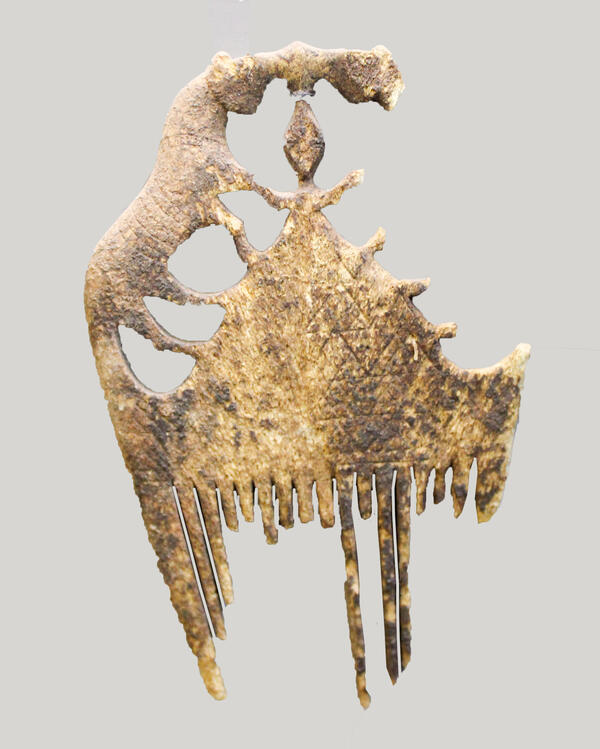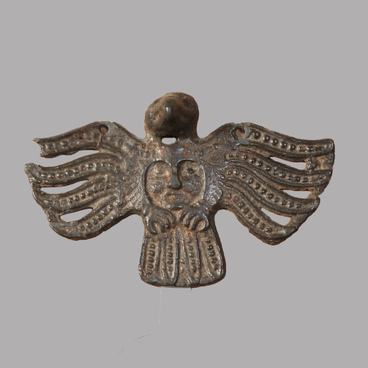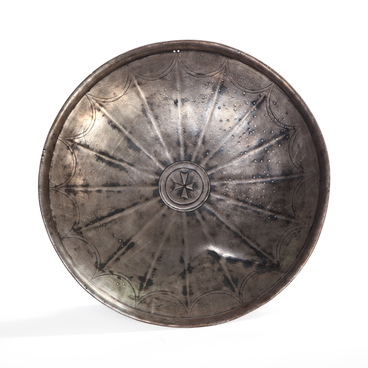Combs were an item of mass use in the Early Middle Ages. They were used to keep hair tidy and comb out parasites, as well as to serve as an auxiliary tool in spinning and weaving. Finno-Ugrians took care of their hair, so most often not only women, but also men, had personal combs.
The combs were made of wood, animal horns and mammoth ivory. Bone carvers were highly rated, and people identified the status of the comb’s owner by the complexity of the pattern on the comb. A broken comb was not usually disposed of but repaired or used in some other way. For example, chipped teeth of a comb could be carefully cut off and used as a tool to apply a pattern on earthenware in a pottery workshop. Later combs were made of copper and bronze always with a through hole to suspend them from a belt.
Combs with images of animals in the Perm animal style served as charms and amulets. Items featuring horses, moose, birds and bears are referred to as zoomorphic and are most often found in women’s and men’s burial complexes. For the deceased women, the comb was fixed in the right plait, while for men it remained on the belt.
The most popular image in the decor of bone combs is a horse, hence its name —the horse comb of the Kama type. The cult of the horse for the peoples of the Great Perm was the most important one, this animal was highly valued as a protector, messenger and helper. The Mari people had the following proverbs about horses: “A horse is a man’s wings”, “A household without a horse is like a man without a head”. The motif of paired horses is common both to Slavic and Finno-Ugrian cultures, and it survived until the early 20th century in peasant bronze and copper combs, wood carvings, embroidery and house decorations.
A fragment of a comb from the collection of the Komi-Permyak Local History Museum was found 62 years ago in a man’s burial during excavations at the Plyosinsky burial ground in Perm region, a monument of the Lomovatovsky culture. The fragment is badly worn, the bone is darkened, some teeth and the top are chipped off. The comb is decorated with a figure of a schematically depicted standing horse.
The combs were made of wood, animal horns and mammoth ivory. Bone carvers were highly rated, and people identified the status of the comb’s owner by the complexity of the pattern on the comb. A broken comb was not usually disposed of but repaired or used in some other way. For example, chipped teeth of a comb could be carefully cut off and used as a tool to apply a pattern on earthenware in a pottery workshop. Later combs were made of copper and bronze always with a through hole to suspend them from a belt.
Combs with images of animals in the Perm animal style served as charms and amulets. Items featuring horses, moose, birds and bears are referred to as zoomorphic and are most often found in women’s and men’s burial complexes. For the deceased women, the comb was fixed in the right plait, while for men it remained on the belt.
The most popular image in the decor of bone combs is a horse, hence its name —the horse comb of the Kama type. The cult of the horse for the peoples of the Great Perm was the most important one, this animal was highly valued as a protector, messenger and helper. The Mari people had the following proverbs about horses: “A horse is a man’s wings”, “A household without a horse is like a man without a head”. The motif of paired horses is common both to Slavic and Finno-Ugrian cultures, and it survived until the early 20th century in peasant bronze and copper combs, wood carvings, embroidery and house decorations.
A fragment of a comb from the collection of the Komi-Permyak Local History Museum was found 62 years ago in a man’s burial during excavations at the Plyosinsky burial ground in Perm region, a monument of the Lomovatovsky culture. The fragment is badly worn, the bone is darkened, some teeth and the top are chipped off. The comb is decorated with a figure of a schematically depicted standing horse.




